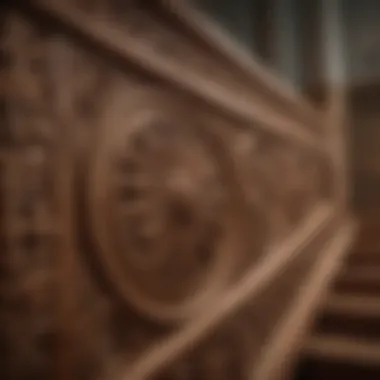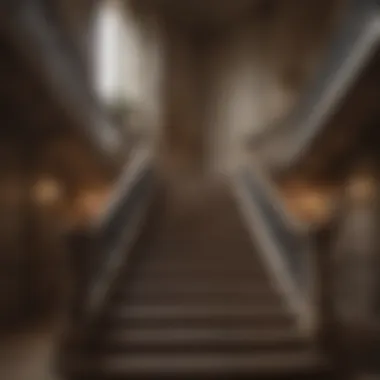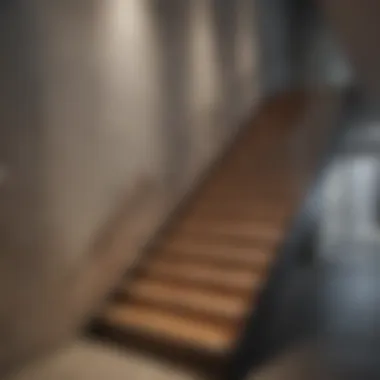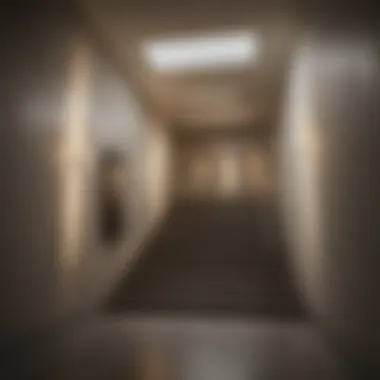Unveiling the Architectural Splendor of Stairwells and Staircases


Outdoor Decor Ideas
As we step into the captivating realm of stairwells and staircases, we find ourselves immersed in a world where architectural mastery converges with practical necessity. These foundational elements have long served as conduits for movement and expression, embodying a timeless fusion of art and utility. From the grandeur of ancient structures to the sleek modern designs of today, the evolution of staircases is a testament to human ingenuity and innovation.
Seasonal Inspirations
Exploring stairwells amidst the changing seasons offers a unique perspective on how natural elements interact with man-made structures. Whether adorned with vibrant blooms in spring or glistening with frost in winter, staircases can be transformed to reflect the spirit of each season. Imagine a delicate dusting of snow on ancient stone steps or a cascade of autumn leaves leading the way - seasonal inspirations breathe new life into these architectural features.
Furniture Selection
When considering outdoor stairwells, furniture selection plays a crucial role in enhancing both aesthetic appeal and comfort. Choosing pieces that complement the architectural style and provide a cozy setting can elevate the overall ambiance. From wrought iron benches to weather-resistant wicker chairs, the right furniture can turn a staircase landing into a serene oasis of relaxation.
Decorative Lighting
The interplay of light and shadow on staircases adds a layer of visual intrigue to outdoor spaces. Decorative lighting fixtures strategically placed along the steps can create a magical atmosphere after dusk, guiding guests with gentle luminosity. Whether lanterns casting a warm glow or sleek LED strips accentuating modern lines, the right lighting transforms stairwells into enchanting pathways.
Plant Arrangements
Integrating plant arrangements into stairwell design brings nature's beauty to the forefront, blurring the lines between indoors and outdoors. Cascading vines, potted succulents, or vibrant floral displays can frame staircases with verdant elegance. By harmonizing plant life with architectural elements, a seamless connection to the natural world is forged.
Hardscaping Solutions
In the realm of outdoor decor, hardscaping solutions play a vital role in shaping the aesthetic and functionality of stairwells. The choice of materials, whether rugged stone, polished concrete, or rich hardwood, influences the overall character of the space. From minimalist Zen-inspired designs to opulent classical motifs, hardscaping guides the visual narrative of outdoor environments.
Sustainable Practices
Embracing sustainable practices in stairwell design not only contributes to environmental conservation but also aligns with a conscious approach to architecture. Utilizing eco-friendly materials, incorporating energy-efficient lighting, and implementing water-saving irrigation systems are just a few ways to create environmentally responsible stairwells. By prioritizing sustainability, we not only enrich outdoor spaces but also preserve the planet for future generations.
Introduction
Stairwells and staircases hold a pivotal role in the realm of architectural design, serving as not just mere conduits for movement but as expressive pieces of artistry that have evolved through the annals of time. This article embarks on a captivating journey to unravel the historical significance, design intricacies, and practical implications of these fundamental structural elements that grace our built environments. By delving into the captivating narrative of staircases, we gain a profound understanding of how they intricately blend form with function, aesthetics with utility.
From the winding staircases of ancient civilizations to the sleek, contemporary designs of modernity, every step, every turn tells a story steeped in innovation and cultural heritage. Examining the key role stairwells play in shaping spatial dynamics and safety protocols, we delve into the very essence of what makes them essential components of architectural composition. Through this insightful exploration, we pave the way for a deeper appreciation of the seamless integration of form and function within the realm of architectural design.


Ancient Origins
Staircases trace their roots back to ancient civilizations, where they symbolized progression and hierarchy in societal structures. The crude yet majestic stairwells of bygone eras spoke volumes about the craftsmanship and engineering prowess of early architects. These early designs, often embodying a blend of functionality and symbolic significance, set the stage for the staircases we traverse today. Venturing through ancient ruins and historical sites, one can appreciate the grandeur of staircases that stood the test of time, a testament to human ingenuity.
Medieval Advancements
As civilization progressed, so did the sophistication of staircases. The medieval era ushered in an era of architectural advancement, where spiraling stairwells and grand staircases became emblematic of power and prestige. These structures not only connected different levels of a building but also served as centers of attention, with intricate carvings and embellishments adorning their steps. The evolution of staircases during this period reflected not just a need for vertical circulation but an aspiration for architectural magnificence.
Renaissance Influences
During the Renaissance period, staircases underwent a transformation, becoming focal points of architectural expression and artistic innovation. Architects and designers of this era infused stairwells with a sense of harmony, proportion, and beauty, drawing inspiration from classical forms and mathematical precision. The grandeur of Renaissance staircases, with their sweeping curves and ornate details, captured the essence of an era marked by cultural rebirth and creative exuberance. These staircases not only facilitated movement but also served as canvases for artistic exploration and architectural mastery.
History of Staircases
In the grand tapestry of architectural evolution, the history of staircases stands as a foundational thread, weaving together the progression of human ingenuity and structural design. The significance of delving into the historical trajectory of staircases within the context of this article lies in unraveling the intricate narrative of how these essential elements have transcended mere functionality to become statements of artistry and cultural significance. By exploring the historical origins and advancements in staircase design, readers are given a glimpse into the progression of human civilization and the intrinsic connection between architecture and societal development.
Ancient Origins
The roots of staircases can be traced back to ancient civilizations, where rudimentary forms of stairs were carved into stone structures to facilitate vertical movement within architectural spaces. These early staircases, simplistic in design yet of profound importance, reflect the human quest for verticality and spatial organization. The ancient origins of staircases reveal not just a utilitarian need but also a symbolic representation of the ascent towards higher realms, blending the physical with the metaphysical in a harmonious amalgamation of form and function.
Medieval Advancements
The medieval era heralded a significant transformation in staircase design, with advancements in construction techniques and architectural principles leading to the emergence of more sophisticated staircases within castles, cathedrals, and manor houses. The architectural landscape of the Middle Ages was characterized by spiral staircases, grand stairwells, and imposing stone steps, each embodying a unique blend of strength, elegance, and functionality. The medieval advancements in staircase design not only served practical purposes but also symbolized hierarchy, power, and prestige, becoming symbolic focal points within the grandeur of medieval structures.
Renaissance Influences
As the Renaissance dawned, ushering in an era of renewed artistic fervor and intellectual exploration, staircases underwent a renaissance of their own, reflecting the spirit of innovation and humanistic ideals permeating the period. Renaissance staircases became elaborate showcases of architectural mastery, featuring graceful curves, intricate balustrades, and ornate detailing that showcased the craftsmanship of master artisans. The influences of the Renaissance extended beyond mere aesthetics, with staircases becoming symbolic conduits of knowledge, enlightenment, and aesthetic delight, embodying the essence of humanism and classical revival in their design and execution.
Design Elements
In the realm of architectural composition, the design elements of staircases and stairwells serve as pivotal facets that dictate not only the physical structure but also the aesthetic appeal of a space. Within this article, the focus lies on dissecting the intricate details that encompass the design elements, shedding light on their undeniable significance in the construction world. Discussing the specific elements that compose staircases, such as handrails, balusters, treads, and risers, will offer a comprehensive view of the meticulous craftsmanship required to create a functional yet visually pleasing staircase. Moreover, delving into the benefits of thoughtful design elements like the impact on spatial perception, user experience, and overall ambiance will underscore the crucial role they play in shaping architectural marvels. Lastly, considering the aesthetic considerations intertwined with design elements, such as the use of varying materials, colors, and textures, will shed light on the delicate balance between form and function that architects and designers meticulously navigate to create truly remarkable staircases.
Architectural Styles


As we explore the realm of architectural styles within the context of staircases, it becomes apparent that these vertical structures have been shaped by diverse design philosophies and cultural influences throughout history. From the intricate patterns of Gothic architecture to the sleek minimalism of contemporary design, staircases have evolved to reflect the prevailing architectural trends of their time. By delving into the characteristics of different architectural styles like Baroque, Rococo, Modernist, and Postmodernist, we can appreciate how each era has left its unique imprint on the staircases we encounter today. Understanding the evolution of architectural styles not only provides insights into the craftsmanship and artistic expressions of different periods but also serves as a testimony to the enduring allure of staircases as architectural masterpieces.
Materials and Construction
The choice of materials and construction techniques employed in crafting staircases is a pivotal aspect that influences both their durability and visual appeal. Within this section, we delve into the diverse array of materials used-Whether lush hardwoods, sturdy metals, or innovative glass elements-to comprehend how each material confers distinct characteristics to the staircase. Exploring the nuances of construction techniques, such as traditional carpentry methods or cutting-edge modular approaches, offers a glimpse into the craftsmanship required to bring these functional structures to life. By scrutinizing the interplay between materials and construction, readers can gain a deeper appreciation for the precision and artistry that underpin the creation of staircases that seamlessly blend robustness with elegance.
Aesthetic Considerations
Stirring the senses and evoking emotions, the aesthetic considerations surrounding staircases provide a captivating look into the fusion of art and function. In this section, we embark on a journey through the visual intricacies that define the aesthetic appeal of staircases, from the graceful curves of a sweeping staircase to the geometric precision of a spiral design. By examining the interplay of light, shadow, and form, we uncover how designers leverage visual elements to create dramatic focal points within a space. Additionally, delving into the role of color palettes, textures, and ornamentation unveils the power of aesthetic choices in imbuing staircases with personality and character. Ultimately, navigating the realm of aesthetic considerations offers a profound understanding of how these design decisions contribute to the overall ambiance and allure of staircases in architectural compositions.
Functionality and Practicality
Staircases play a pivotal role in architectural structures, not just as a means of vertical circulation but also as a design element that can dictate the overall aesthetics of a space. In this article, the significance of Functionality and Practicality is paramount, as it encompasses various elements that contribute to the usability and efficacy of staircases. Architects and designers must carefully consider the spatial layout and user experience when conceptualizing stair designs ** to ensure seamless integration with the surrounding environment. Thoughtful planning of staircases can optimize space utilization, providing efficient vertical connections while enhancing the visual appeal of a space.
Spatial Efficiency
Spatial Efficiency is a critical aspect of staircase design, focusing on how effectively the available space is utilized to accommodate the staircase without compromising functionality or aesthetics. In the context of staircases, spatial efficiency goes beyond mere physical dimensions; it involves a meticulous analysis of traffic flow patterns, ergonomic considerations, and seamless integration with the overall architecture. By prioritizing spatial efficiency, designers can create staircases that not only fit seamlessly within the spatial context but ** strategic use of available space for additional purposes, such as storage or seating areas.
Safety Measures
When discussing staircases, Safety Measures are of utmost importance to ensure the well-being of users. Factors such as tread depth, handrail design, lighting, and slip resistance are integral components of staircase safety. In this section, we delve into the critical role that safety considerations play in staircase design. Implementing industry standards and regulations regarding safety measures is essential to mitigate risks and enhance user experience. From proper lighting installations to non-slip surfaces, each safety measure contributes to creating a secure and user-friendly staircase environment.
Accessibility Features
In the realm of staircase design, Accessibility Features are key elements that cater to users with diverse needs. Whether addressing mobility concerns or enhancing usability for all individuals, incorporating accessibility features is imperative for creating inclusive designs. This section delves into the innovative ways in which designers can ensure that staircases are easily navigable for everyone, regardless of their physical abilities. From incorporating ramps and elevators to carefully designing handrails and lighting for optimal visibility, accessibility features are instrumental in making staircases universally accessible and user-friendly.
Modern Innovations
In the section of Modern Innovations, we delve into the crucial role that contemporary advancements play in shaping the evolution of staircases and stairwells. LookIng closely at the intricate blend between functionality and aesthetics, we examine how modern innovations push the boundaries of design. From cutting-edge materials to revolutionary construction techniques, the realm of Modern Innovations offers a playground for architects and designers to showcase their creativity. As we navigate through this segment, we highlight the significance of staying abreast of the latest trends and technologies in the field of architecture and interior design.
Technological Advancements
In discussing Technological Advancements within the domain of staircases and stairwells, we unpack the transformative impact that technology has had on the design and construction processes. With the integration of smart systems, digital fabrication methods, and 3D modeling tools, the possibilities in creating innovative staircases are endless. We analyze how these advancements enhance precision, efficiency, and sustainability in the architectural landscape, paving the way for unprecedented levels of customization and precision engineering.


Contemporary Designs
Within the realm of Contemporary Designs, we explore the intersection of tradition and modernity in stairwell architecture. By merging classic design principles with avant-garde aesthetics, contemporary staircases exude a unique charm that speaks to both heritage and innovation. Through a detailed examination of minimalist styles, geometric patterns, and open-concept structures, we unravel the visual symphony that defines contemporary staircase designs. We dissect the influence of renowned architects and interior designers in reshaping the narrative of modern stairwells, offering a fresh perspective on spatial dynamics and interior aesthetics.
Sustainable Practices__
In the context of Sustainable Practices, we emphasize the growing emphasis on eco-friendly solutions and green design principles in the realm of staircases and stairwells. By championing sustainable materials, energy-efficient techniques, and responsible construction practices, architects are pioneering a new wave of environmentally conscious design. We delve into the logistical challenges and innovative strategies that underline sustainable staircase construction, underscoring the importance of harmonizing functional elegance with ecological responsibility. Through a lens of sustainability, we explore how staircases can serve as exemplars of ethical design practices, aligning luxury with eco-consciousness for a more sustainable future.
Cultural Significance
Stairwells and staircases hold a profound cultural significance that transcends mere functionality. These architectural elements serve as tangible representations of societal values, beliefs, and aspirations throughout history. The intricate designs and embellishments found in staircases often reflect the cultural heritage and artistic styles of the eras in which they were constructed. From the grandeur of ancient civilizations to the minimalistic elegance of modern designs, each staircase tells a unique story embedded in cultural contexts. Furthermore, the significance of staircases extends beyond aesthetics; they act as social connectors, bridging different levels of a structure physically and symbolically. The cultural importance of staircases lies in their ability to capture the essence of a culture through architectural craftsmanship and spatial design.
Symbolism and Metaphors
Conversely, symbolism and metaphors associated with staircases add another layer of depth to their cultural significance. Staircases are often symbolic of progress, transition, and personal growth. The act of ascending or descending stairs mirrors the journey of life, with each step representing a new phase or challenge. In art and literature, staircases are frequently used as symbolic motifs to convey themes of transformation, enlightenment, and self-discovery. Metaphorically, staircases embody the idea of ascension towards higher knowledge or spiritual enlightenment. Through symbolic interpretations, staircases transcend their physical form and become metaphors for the human experience.
Iconic Staircases in History
Throughout history, certain staircases have achieved iconic status due to their architectural magnificence or historical significance. Examples include the spiral staircase in the Vatican Museums, renowned for its intricate design and architectural beauty. Another iconic staircase is the Tulip Staircase in Queen's House, Greenwich, famous for its elegant spiral form and historical charm. These iconic staircases not only serve as architectural marvels but also hold cultural and historical importance, drawing visitors from around the world to marvel at their grandeur.
Social Interpretations
Social interpretations of staircases delve into the way these structures influence human interactions and societal dynamics. Staircases serve as social spaces where people gather, linger, and move between different levels of a building. In social contexts, staircases play a role in shaping human behavior and facilitating social encounters. Whether in grand palaces or humble homes, staircases serve as meeting points and transition zones where individuals from diverse backgrounds converge. Social interpretations of staircases illuminate their role in fostering connections, facilitating movement, and shaping social hierarchies within architectural spaces.
Future Prospects
Staircases and stairwells, while deeply rooted in architectural history, continue to evolve in line with modern trends and technological advancements. A critical aspect of this evolutionary process is exploring the future prospects of these essential structural elements. By looking ahead and anticipating upcoming innovations, designers and architects can stay at the forefront of cutting-edge design principles and construction techniques. Future prospects in staircases encompass a wide array of considerations, from sustainable materials to futuristic designs that prioritize both form and function. Understanding these future prospects not only allows professionals to push the boundaries of creativity but also fosters a culture of eco-consciousness and adaptability within the architectural domain.
Innovative Trends
Innovative trends in staircase design reflect the ever-changing landscape of architecture and interior aesthetics. From minimalist, Scandinavian-inspired staircases to bold, avant-garde creations, the world of staircase design is a canvas for artistic expression and structural engineering ingenuity. Embracing innovative trends involves a continuous process of exploration and experimentation with new materials, shapes, and spatial configurations. Designers today are pushing the envelope by incorporating technological elements such as smart lighting systems, motion sensors, and even kinetic designs that adapt to users' movements. By staying attuned to innovative trends, architects can create staircases that not only serve a practical purpose but also elevate the overall visual appeal of a space, making a definitive statement in modern interior design.
Adapting to Changing Needs
Adapting to changing needs is an essential aspect of staircase design, especially in a rapidly evolving architectural landscape. As lifestyles evolve and urban spaces transform, the role of staircases goes beyond mere functionality to serve as multifunctional elements that adapt to the diverse needs of inhabitants. Incorporating elements such as storage solutions, convertible designs, and multi-use spaces within staircase structures ensures optimal utilization of space while catering to changing lifestyle demands. Designers must anticipate these changing needs and incorporate flexible design elements that can seamlessly integrate into different living environments, whether it be a compact urban dwelling or a sprawling countryside estate. By adapting to changing needs, staircases can transcend their traditional role and become versatile design elements that enhance the overall living experience.
Artistic Explorations
Artistic explorations in staircase design offer a gateway to merging architectural functionality with creative expression. From sculptural installations to interactive art pieces, artists and designers are redefining the boundaries of conventional staircase design through bold artistic explorations. Artistic staircases not only serve as functional means of vertical circulation but also act as focal points that spark conversations and evoke emotions. By collaborating with artists, architects can infuse staircases with a sense of personality and narrative, transforming them into experiential journeys that transcend mere utility. Artistic explorations in staircase design blur the line between architecture and art, inviting individuals to engage with spatial elements in a multifaceted and thought-provoking manner.







